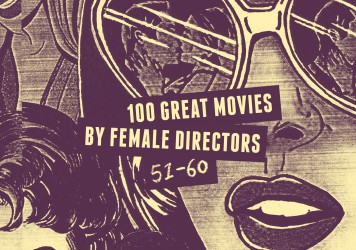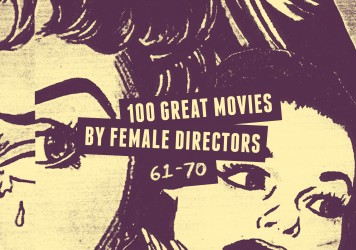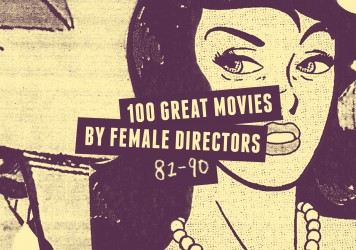
Golden Bear-winning drama from Peru and Essex social realism star in this part of our female filmmaker compendium.
This heartbreaking twist on the traditional father-son/father-daughter bonding tale sees a working stiff from a Uruguayan fishing village coming to terms with being a single parent to a child in possession of both sex organs. Though Ricardo Darín – the George Clooney of Argentina – might be construed as the central draw, the real emotional core of Lucia Puenzo’s emotionally harrowing film is provided by the young actress Inés Efron, who grasps her character’s gender fluid status without ever suggesting it’s the sole defining trait of a young life. The film takes place at the age when Efron’s character, Alex, is reaching sexual maturity, and there’s a drive to try and experience love in a way which casts her potential outsider status to the side. The movie is alternately joyous and upsetting, presenting the empathy and support Alex receives from progressive friends and peers – who incidentally refuse to accept that he/she would be naturally vilified – as well as the pain of accepting your place in the world and predicting what an unknown future might bring. David Jenkins
In the months preceding the cinema release of Lucrecia Martel’s masterpiece, The Headless Woman, there was a trend of film critics offering forensic readings of the film and offering blurred screen caps to support their have-a-go theses. An affluent woman played by María Onetto is driving down a country road. She is momentarily distracted by her mobile phone, the car judders as it drives over… something… and, with a brief glance in the rear-view, she carries on with her life. It’s just a stray dog, surely. For the remainder of the film, the thought of what actually went under her wheels remains in her mind, like blood that won’t wash away. She receives a mild concussion from the incident, and the film makes an attempt to look at and decipher the world through her slightly discombobulated eyes. More than a bland critique of bourgeois complacency, The Headless Woman is a film about existential torment and the seemingly insignificant moments in life that can send us into a tailspin that might be psychological, but it could just be physiological too. Martel’s direction, her ordering of material, her marshalling of the actors, her fractured editing patterns, her melding of genres, her exploration of social and political mores, is without equal in the 21st century. DJ
For more cinematic examples of watching what happens when toddlers are abandoned by their parents, see also Valérie Massadian’s Nana (number 87 on our list). Here, Korean-born, US-based director So Yong Kim tells the tale of two young sisters who are charged with making their own entertainment when their mother shapes up and ships out in a bid to locate the girls’ estranged father. “Big Aunt” is handed the parenting reigns, and her strategy for child-rearing is laissez-faire to the max, so the girls spend their time traversing the concrete wasteland which makes up the direct environs of their temporary home, and attempt to keep themselves out of trouble. Kim’s film looks at the ways in which the very young employ their burgeoning sense of imagination to protect themselves from the horrors of the world, but also as way to interpret the mysterious actions undertaken by adults. At one point, the girls create their own economic eco-system by creating a snack business based the sale of grasshopper kebabs. Aww… DJ
The story of Wendy & Lucy is a simple one. On her way to Alaska where she hopes to find a job, young Wendy stops off in a small town in Oregon. She is travelling with her dog, Lucy, the only being who truly cares for her, and the only one that she cares for. But money runs short after a series of incidents, and Lucy disappears. From such an unexciting, not to say banal, premise, Reichardt creates a neorealist film for 21st-century America. By simply observing the harsh reality of unemployment, homelessness and the absence of healthcare, she avoids all sentimentalism to leave only the raw emotions emanating from an encounter with unfairness in a very real world. Similarly, Wendy barely cries at all despite her hardships – she only accepts other people’s help with great resignation. She is at odds with her environment, a small figure against a grand background. She is rarely photographed at the centre of the frame, except when she is with Lucy. Circumstances have no compassion, but this film is about how Wendy is strong enough to accept them. Manuela Lazic
Cinema is littered with men who objectify women as their muses, figures to be looked at, adored but never truly understood. In Bright Star, the Romantic poet John Keats (Ben Whishaw) – a literary figure prone to objectification – is addressed by Jane Campion, who represents him from the perspective of his ‘muse’, Fanny Brawne (Abbie Cornish). But this muse is anything but submissive: “Bright star, would I were steadfast as thou art,” writes Keats, a frail man at this woman’s mercy. The film secludes us in the emotional cloister that Keats builds around Brawne, but it is resolutely her journey we are on. Yet no matter how mysterious and miserable her lover might appear, steadfast Brawne is never suspicious of him. She claims to see things in his failed poetry that no one else does. Once in love, he starts writing more and the film is careful to let his poetry alone so as to reveal the deepness and beauty of his character, and most of all of his sentiments for Fanny. A perfect homage not only to Keats’ words but also to the lovers themselves, Bright Star is a refreshing take on the prototypically ‘male’ story of creative endeavour. Elena Lazic
It’s unlikely that an audience or its maker would describe the masterful Craneway Event as a “feature film”, much less a documentary (she has described it as a “document,” however), though that does not preclude us from wanting to flag it up in this list. British artist/filmmaker Tacita Dean opted to capture dance rehearsals of what were to be the last hurrah of lauded choreographer, Merce Cunningham, who intones his precise commands from a wheelchair on the sidelines of an ad-hoc modernist ballroom. What makes this a thing of miraculous beauty is the fact it takes place in a repurposed car assembly plant located on a dockside in Richmond California, and while the shallow focus remains on the supple bodies of the dancers, the deep focus reminds of the surrounding environment and the ghosts of the past, always present through the giant bay windows. Mercer died shortly after the filming, and this stands as a moving monument to his genius and the way he saw the human body as primal conduit for great art. A thesis which Dean confirms with this film. DJ
Ninety seven minutes and two shots is all it took to make this quietly transcendent epic by American director Sharon Lockhart. Though her camera is trained on two vistas for roughly 45 minutes a piece, your eye is invited to drink in the details that speckle the frame. All of a sudden, a bird flying through the sky, a particularly strong gust of wind, the shape of a cloud or the intensity of the light become the thematic marrow of this hypnotic work. At its centre, though, is a woman digging for clams on a muddy, waterside verge in Maine, and Lockhart draws on both the musicality of her repeated movements, and the image of a woman, alone, in union with the earth as the sun rises and sets above her. It’s about time and work, and the time we spend working. DJ
This dazzling film deserves to be spoken of in the same breath as classics such as Rossellini’s Journey to Italy or Bergman’s Scenes From a Marriage. A young, hip German couple who lounge around in chiffon gym shorts and low-riding jeans in a secluded Sardinian apartment, engage in a drawn-out war of emotional attrition, far enough along in their relationship to be brutally honest with one another, but not far enough to feel like they sometimes operate dangerously close to the edge when it comes to friendly goading and light humiliation. As played by Lars Eidinger and Birgit Minichmayr, this gruesome twosome are a hipster hotbed of combustible feelings, their relationship seemingly bound together through their abhorrence towards others. Maren Ade just stands and watches as the pair’s bickering turns to anger turns to resentment turns to forgiveness turns to self-abasement turns to passion turns to boredom, each scene offering a surprise emotional twist, the couple unable to maintain a happy stasis. The moment the film ends feels like it could be a moment of high transcendence, with Ade boldly offering a solution to all life’s problems which is on a par with a pie fight in the War Room. Films about couples tend to want an audience to pine for them to stay together or to break up – with Everyone Else, the idea of such simplicity is laughable. DJ
In a year that, for better or worse, British film made a fair amount of noise on the international stage (for every An Education there was a The Boat That Rocked), Andrea Arnold’s staggeringly good second feature demanded that everyone just shut up and listen. How could we do anything but? Boasting a pair of knock-out central performances from newcomer Katie Jarvis – who famously was approached by a casting agent after being spotted arguing with her boyfriend on a railway station platform – as 15-year-old Mia and Michael Fassbender as her mum’s new beau, the writer/director’s Essex drama mixes vital social commentary with harsh coming-of-age realism while moving to its own distinct rhythm. It’s a film of devastating moments in which Arnold’s subtle use of visual metaphor creates a suffocating atmosphere that mirrors the cramped housing estate setting. Her next project, the Shia LaBeouf starring American Honey, is currently in post-production. We’ll be front of the queue when it’s released in 2016. Adam Woodward
Like so many before her, director Claudia Llosa went and blotted a fairly clean copy book when she opted to leave her native Peru to make a film in the English language. Her 2014 film, Aloft, starring Jennifer Connelly, incited smirks of derision towards its po-faced sense of agony when it played at the Berlin Film Festival in 2014, an incident that must’ve hit her with double force considering just five years prior to this, she had picked up the Golden Bear for her second feature, The Milk of Sorrow. The film is an eccentric study of stunted feminism which takes place directly after a period of political unrest – the late ’80s under the rule of Shining Path. Rape and abuse are commonplace in Lima, and so working class women are forced to take the only precautions available to them. Magaly Solier’s Fausta is suffering from a rare condition manifest in her breast milk, and when doctors inspect her body further, they discover a potato growing in her uterus, placed there as a form of cheap, homemade contraception. The film is a character study in which Fausta’s casual self-mutilation speaks volumes about a country discovering wounds it didn’t know existed. DJ
Read more 100 great movies by female directors: 1-10 | 11-20 | 21-30 | 31-40 | 41-50 | 51-60 | 61-70 | 81-90 | 91-100
Published 17 Jul 2015

Riding whales, Huey Lewis and cannibalism crop up in the sixth part of our epic countdown.

Miracles and mutilation feature in this part of our survey of great works directed by women.

The Brits are out in force in the ninth segment of our massive celebration of women who make movies.